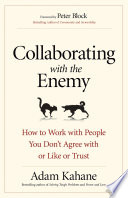

The book begins by addressing the nature of adversarial relationships in the workplace and beyond. It presents the idea that not all conflict is negative; rather, it can be a catalyst for growth and innovation. The author emphasizes the importance of recognizing the value in opposing viewpoints and how they can drive better decision-making and creativity. By understanding that adversaries can provide critical insights and challenge our assumptions, we can shift our mindset from viewing them as obstacles to seeing them as potential collaborators in problem-solving. This shift is crucial for fostering a culture of open dialogue and constructive conflict, which can lead to more effective collaboration.
Continue readingThe book outlines a spectrum of collaboration that ranges from competitive to cooperative interactions. The author discusses how different situations may call for different approaches to collaboration, emphasizing that not every relationship needs to be harmonious. Understanding where you and your adversary fall on this spectrum can help you tailor your approach to collaboration. For instance, in a highly competitive environment, it may be necessary to adopt a more strategic form of collaboration, whereas in a cooperative setting, open communication and trust can foster deeper connections. This idea encourages readers to be flexible and adaptable in their collaboration strategies.
Continue readingTrust is a fundamental element in any collaborative effort, even with adversaries. The author discusses strategies for building trust, such as active listening, empathy, and transparency. By demonstrating a willingness to understand the other party's perspective and showing genuine interest in their concerns, individuals can establish a foundation of trust that facilitates better collaboration. The book also highlights the importance of consistency and reliability in building trust over time. This idea reinforces the notion that trust is not built overnight but requires ongoing effort and commitment.
Continue readingNegotiation is often viewed as a competitive process, but the book reframes it as a collaborative tool. The author emphasizes the importance of approaching negotiations with a mindset of mutual benefit rather than adversarial gain. By focusing on shared interests and common goals, parties can find creative solutions that satisfy both sides. The book provides practical strategies for negotiating effectively, such as preparing thoroughly, being open to compromise, and maintaining a focus on long-term relationships rather than short-term wins. This perspective encourages readers to view negotiations as opportunities for collaboration rather than conflict.
Continue readingCollaboration with adversaries often involves engaging with diverse perspectives that may challenge our own. The book stresses the value of diversity in fostering innovation and creativity. By bringing together individuals with different backgrounds, experiences, and viewpoints, teams can generate a wider array of ideas and solutions. The author encourages readers to embrace diversity as a strength rather than a challenge, highlighting how varying perspectives can lead to more robust outcomes. This idea underscores the importance of inclusivity in collaborative efforts, as it can enhance problem-solving capabilities.
Continue readingThe book provides readers with a toolkit of conflict resolution strategies that can be applied in collaborative situations. These strategies include techniques for de-escalating tension, finding common ground, and facilitating open communication. The author emphasizes the importance of remaining calm and composed during conflicts, as emotional reactions can hinder productive dialogue. By equipping readers with practical skills for resolving conflicts, the book empowers individuals to navigate challenging interactions with adversaries more effectively, ultimately leading to better collaboration.
Continue readingFinally, the book concludes by discussing the long-term benefits of collaborating with adversaries. While it may be tempting to view adversarial relationships as purely transactional or conflictual, the author argues that fostering collaboration can lead to sustained partnerships and opportunities for growth. By investing in relationships with adversaries, individuals and organizations can unlock new avenues for innovation, learning, and success. This idea encourages readers to think beyond immediate challenges and consider the broader implications of their collaborative efforts.
Continue reading